How do I enter a supplemental check? (Checklist)
Enter Supplemental Checks
Print a check that falls between payroll checks. When you want to increase the employee's pay. you may give supplemental pay in the form of bonuses, commission pay, overtime pay, payments for accumulated sick leave, severance pay, awards, back pay, retro pay increases, and payments for nondeductible moving expenses.
Note: You may be required by law to provide supplemental wages if an employee works overtime.
Supplemental wages can be given with the employee's regular wages or they can be paid separately. Supplemental wages are non-regular wages, which means federal income tax withholding may be different from the federal withholding tax on regular wages. Social Security and Medicare taxes on supplemental wages are withheld the same way as you would withhold for regular wages.
Use the first checklist to create a supplemental check for a supplemental check that's created outside a normal payroll checklist. It includes the steps you should complete to calculate benefits, federal taxes, and state taxes; print checks or print direct deposit vouchers; and pay taxes. If the supplemental check will be created near the time when you will be completing the normal payroll checklist, use the second checklist. The normal payroll checklist includes the steps for calculating benefits and taxes; printing checks or vouchers; and paying taxes.
Watch a video
-
Learn how to use the Supplemental/Termination Checks Checklist to enter a supplemental check (03m36s) and termination check (41m58s). [MP4]
Download and install the supplemental check checklist
Use this checklist to enter a supplemental check. There's a section for entering a supplemental check outside of the current payroll dates and another section for entering a supplemental check during a normal payroll. This checklist will help you get started; however, you may need to update the steps in the checklist to meet the needs of your organization.
[XML]

Supplemental/Termination Checks Checklist
To install the checklist, click Checklists on the Connect main menu. Click Manage Checklists. Choose Import a Checklist. More
Entering a supplemental check outside of payroll dates
If you're entering a supplemental check that occurs outside the current payroll period, follow this checklist. It will help you enter the supplemental check, calculate benefit amounts, calculate taxes; and set up the direct deposit. For example, use a supplemental check when you need to get a check to an employee right away.
Do I need to create a new pay period for supplemental checks? No, you do not need to create a new pay period to enter supplemental checks or bonus checks. You can enter supplemental checks and bonus checks during the normal payroll period.
Step 1. Modify existing employees
Verify an employee has the correct pay codes and the pay codes are set to calculate based on the amount being paid (Payroll > Employees > Modify Existing Employees > Pay Codes tab). The employee will need the pay codes that will be paid out. In some organizations, the supplemental amount is subject to retirement. You may need to check with your organization to find if the supplemental amount is subject to retirement.
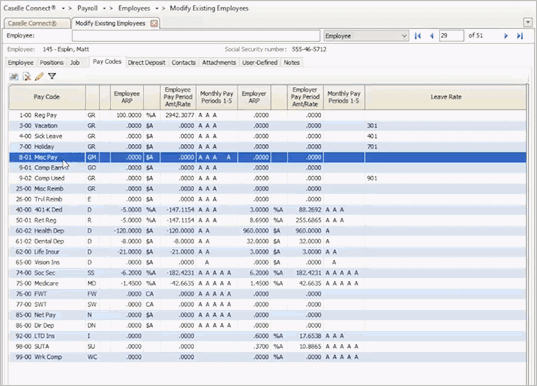
Payroll Modify Existing Employees > Pay Codes tab
Step 2. Enter supplemental checks
Use Payroll > Employees > Enter Supplemental Checks. (See 7m00s in the video.)
Can I use enter payroll checks to enter a supplemental check? No, you should use the Enter Supplemental Checks view to enter supplemental checks.
A. Set up Enter Supplemental Checks options
In the Options window, you can choose to create a paper check or direct deposit. In this example, the Options are set up to print a paper check and the Print Check After Entry menu is set to No so you can review the supplemental check before it prints.
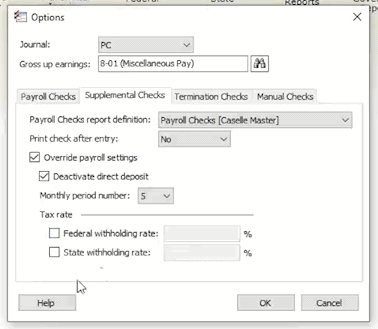
Enter Supplemental Checks - Options
Override payroll settings: Yes
Deactivate direct deposit: Yes
If you're printing a paper check instead of using direct deposit, choose No.
Monthly period number: 5
Enter the payroll period to use to calculate the supplemental check. To calculate a supplemental check without deduction type pay codes, calculate the supplemental check in period 5.
Federal withholding rate:
In most cases, the federal withholding rate in the employee's profile is the correct choice. However, if your organization wants all of the employee's to use a standard percentage on a bonus check, you can use this option to override the tax rate in the employee's profile.
-
To override the employee's standard federal withholding rate that is selected on the employee's W-4, select the checkbox and enter the override federal withholding rate.
-
To use the employee's default federal withholding rate, do not select the checkbox.
State withholding rate:
The state withholding rate works like the federal withholding rate.
-
To override the employee's standard state withholding rate, select the checkbox and enter the override state withholding rate.
-
To use the employee's default state withholding rate, do not select the checkbox.
When you are prompted to, "Open Calculate Payroll Checks and temporarily save these options?" click No.
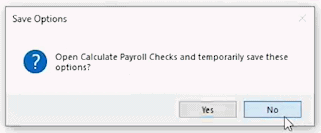
Save Options dialog box
The Enter Supplemental Checks view opens in single check entry mode.
B. Enter supplemental check information
Use the Enter Supplemental Checks view to enter the information that will be used to calculate the supplemental check.
Check issue date:
Change the check issue date if an employee needs the supplemental check for the current date or for a date other than the payroll check issue date that appears in the Check Issue Date box, use the Check Issue Date box to enter a new check issue date. You may receive a warning message if the check issue date is not the same as the check issue date for the pay period. The warning message will not stop you from creating a supplemental check using the check issue date that you have selected.
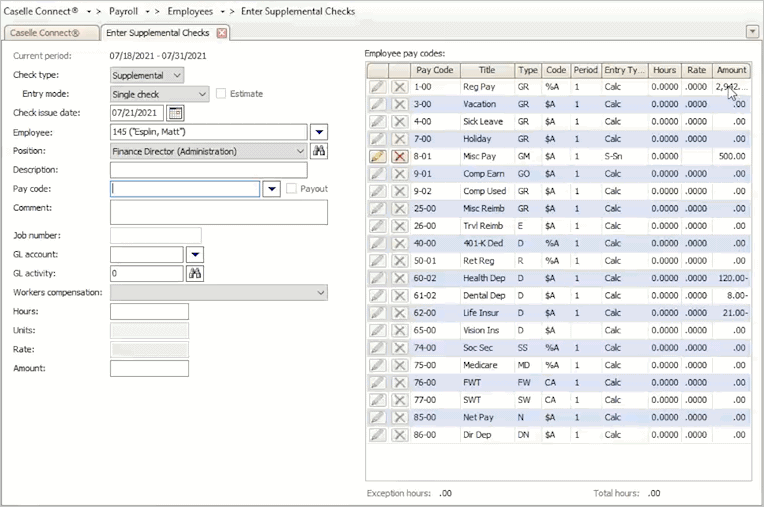
Enter Supplemental Checks - Single Check Entry Mode
Pay code and amount
After you enter a pay code and amount, the Employee Pay Codes section will use the supplemental amount, regular pay amount, and deductions. When you calculate the supplemental check in period 5, the regular pay amount and deductions will go away.
C. Calculate pay codes
You're ready to calculate the supplemental check, click Calculate Pay Codes  (CTRL+C). The Employee Pay Codes section will show the pay codes that will be included in the supplemental check. The pay codes will calculate based on the settings in the employee profile. You can use the Employee Pay Codes section to review the pay codes and amounts. If you are printing a paper check, you should see the pay code is 85-00, Net Pay. If you are using direct deposit, then the pay code should be 86-00, Direct Deposit.
(CTRL+C). The Employee Pay Codes section will show the pay codes that will be included in the supplemental check. The pay codes will calculate based on the settings in the employee profile. You can use the Employee Pay Codes section to review the pay codes and amounts. If you are printing a paper check, you should see the pay code is 85-00, Net Pay. If you are using direct deposit, then the pay code should be 86-00, Direct Deposit.
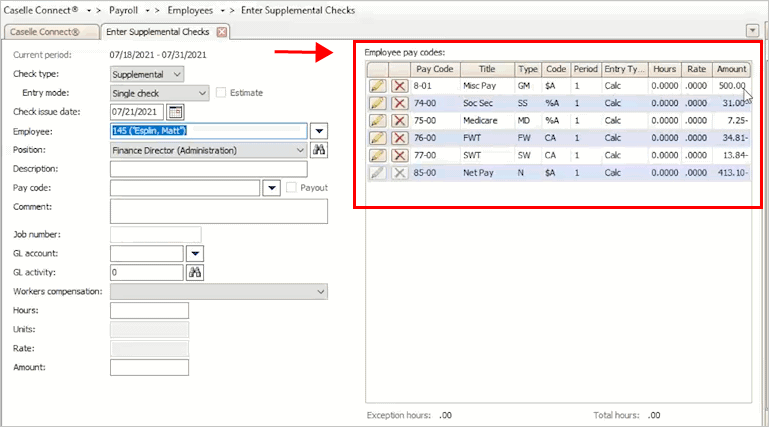
Calculated Employee Pay Codes
If everything looks good, press Enter to save the supplemental check and then click  .
.
Step 3. Print payroll register (optional)
Use Payroll > Reports > Payroll Register and set up the selection criteria to select the employee with the supplemental check. (See 15m30s in the video.) Click Print Preview  (CTRL+Q). You can save the payroll register to the employee file.
(CTRL+Q). You can save the payroll register to the employee file.
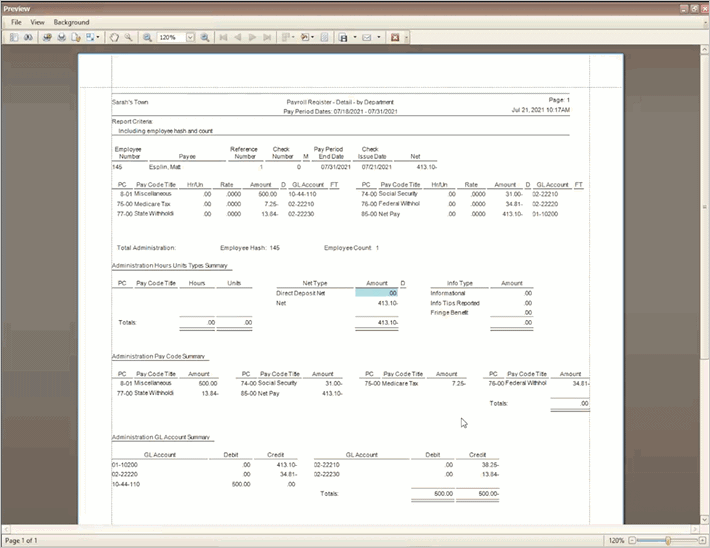
Payroll Register - Preview Report
Step 4. Review payroll register and make corrections
Take a look at the payroll register and look for errors. Are the pay codes correct? Did the pay codes calculate the correct amounts? Is everyone who was supposed to receive a supplemental check included on the report? If you find any errors, you can go back to Enter Supplemental Checks and enter the correct information.
Step 5. Calculate benefit amounts
Golden Rule: In Connect, anytime you calculate a check, you must also calculate benefits.
Open Payroll > Employees > Calculate Benefit Amounts and calculate benefits for the employee(s) with supplemental checks. (See 18m20s in the video.) You can check the calculated employee benefits to make sure only the benefits that should be calculated have been calculated.
If benefits calculated that should not be calculated, use Enter Benefit Adjustments to remove them (see 19m17s) from the check in the selected pay period. It will not affect how the benefits calculate on a check in a normal pay period. More
Step 6. Print benefit register
If you make any changes to the benefit calculations, print the benefit register to verify benefit calculations one more time (Payroll > Reports > Benefit Register). You can also save the report as a PDF or print and file it in the employee's file.

Preview pane - Benefit Register
Step 7. Print pay code transaction report
Use the pay code transaction reports to balance your transmittals (Payroll > Reports > Pay Code Transaction Report.). When you're processing a supplemental check that occurs outside the normal payroll dates, the federal taxes are due within three days of when the employee receives the supplemental check. The three days to pay federal taxes is based off the check issue date. If the three-day window ends before the pay period, run the pay code transaction report to calculate the taxes due on the supplemental check so you can pay the federal and state taxes on time.
Run the following pay code transaction reports:
-
IRS. Shows the employer and employee-side of the federal taxes for the supplemental check (see 25m21s). In this example, the total amount owed to the IRS is $111.31. It's a good idea to save or print a copy of this report. Later when you process the normal pay period, the pay code transaction report for IRS tax deposit may include the supplemental check(s) that you created outside the normal pay period in the grand total. You may need to deduct the taxes that have already been paid on the supplemental check(s) from the taxes that will be paid for the pay period.

Pay Code Transaction Report - IRS Tax Deposit
Remember, you can use the Advanced Options to select the check issue date as the report date range. Using the check issue date will limit the report date range to the check issue date on the supplemental check(s).
-
SWT (if applicable). Shows the employer and employee-side of the state taxes for the supplemental check (see 27m09s). Like the federal taxes, you may want to save or print a copy of this report to help you calculate the state taxes for the normal pay period.
-
Garnishment/Child Support (if applicable).
-
Any state/organization-specific reports
Step 8. Run checkout
Run Checkout for all employees to make sure there aren't any unexpected errors (Payroll > Employees > Checkout).
If you have an employee who has multiple checks who is receiving a supplemental check, that employee may show up on the Checkout error report. This is one error that you can skip. On the other hand, if the Checkout report shows an employee has two checks who shouldn't have two checks, then that's something that should be investigated. You will need to figure out why they have two checks and then delete the check that shouldn't be there.
Step 9. Print payroll check or direct deposit voucher
To print a paper check, run the Payroll Checks report (Payroll > Employees > Payroll Checks) (see 29m29s). Select the check issue date on the supplemental check from the list of dates in the Check Issue Dates box. Set up the payroll check settings as usual. Use the option to preview the supplemental check to look for errors. If the employee is set up for direct deposit, the print preview will show the direct deposit voucher instead of the showing the layout for printing a paper supplemental check.
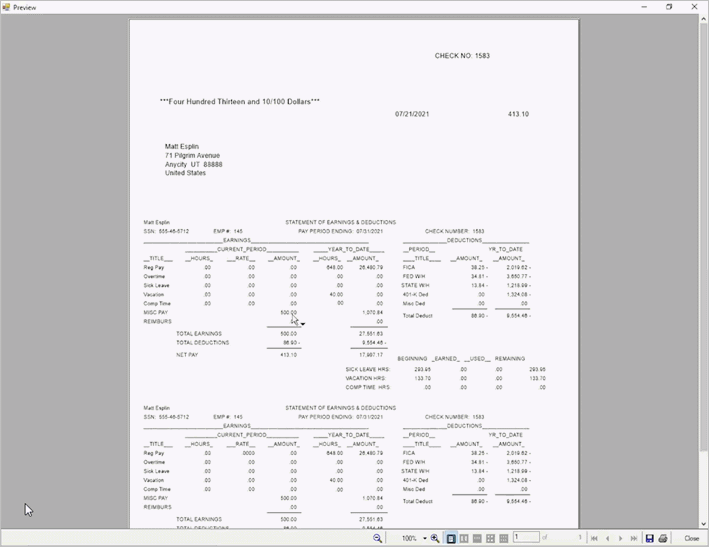
Payroll Checks - Print Preview Supplemental Check
Step 10. Online pay vouchers (NatPay customers)
If you're using NatPay, print the online pay vouchers (see 31m15s). Use Payroll > Employees > Custom Forms/Letters and then select the form for NatPay Online Pay Vouchers. For example, Customer Forms/Letters - Online Pay Vouchers. In the online pay voucher, select the employee(s) who received a supplemental check. Remember, you can use the Advanced Options to use the supplemental check issue date as the date range.
Step 11. Upload NatPay File (NatPay customers)
If you're using NatPay, upload the file to the NatPay portal.
Step 12. Create direct deposit file
If you are creating supplemental checks as a direct deposit, complete this step (Payroll > Employees > Create ACH File) (see 32m18s). Make sure to select the correct pay period and deposit date for the supplemental check(s).
Take care later when you create the ACH file for the normal payroll. Do not select the option recreate transfer file for all employees when you set up the ACH file because it will recreate the ACH file for all employees in the pay period, not just the employees who received a supplemental check. If you select the Recreate Transfer File checkbox, the ACH file will include the supplemental checks that have already been included in another ACH file and the employee would be paid twice. If you have questions, contact customer support at (800) 228-9851.
Step 13. Print payroll register - single-line summary (optional)
Use the single-line summary to review the federal taxes, state taxes, and net pay (34m30s). Open Payroll > Reports > Payroll Register and select the report titled Payroll Register - Single-line Summary [Caselle Master]. Set up the report date range to select the check issue date or set up the selection criteria to select the employee(s) with supplemental check(s).

Payroll Register - Single-line Summary
Step 14. Transmittals
If you are paying an employee a supplemental amount before the normal pay period ends, you will need to pay federal and state taxes to the government (35m28s). When you run your normal payroll, you will subtract the grand total that you paid for the supplemental check(s) from the the IRS Grand Total for the pay period to find the actual amount to pay the IRS for the pay period. Repeat the process to find actual amount to pay state taxes for the normal payroll.
Pay Period IRS Grand Total - Supplemental Check(s) IRS Grand Total = IRS Payment Amount
Pay Period SWT Grand Total - Supplemental Check(s) SWT Grand Total = SWT Payment Amount
Notes:
-
Make IRS, SWT payments online and note how much was paid for the supplemental check(s).
-
When it's time to start the regular payroll process, it's best to calculate transmittals all at once, and then print the voucher for the grand total.
-
When you go online to make your payment for your regular payroll, deduct the amount that you paid for the supplemental check(s).
-
If you have a garnishment/child support payment that must be paid before payroll is calculated, you can calculate the payment amount for the transmittal number and then print a check for the garnishment/child support payment. If you need assistance, contact customer support at (800) 228-9851.
Step 15. Pay IRS taxes
Use your normal method for paying IRS taxes.
Step 16. Supplemental check is complete
You're done!
Additional Notes:
-
Do not update supplemental check transactions to the General Ledger until you have completed the regular payroll.
-
Remember, the supplemental check(s) will show up on the following reports during the payroll process: Payroll Register, Benefit Register, and Pay Code Transaction Report.
Entering a supplemental check during a normal payroll
If you're entering a supplemental check that occurs inside the current payroll period, complete this checklist before you begin the regular payroll checklist.
Do I need to create a new pay period for supplemental checks? No, you do not need to create a new pay period to enter supplemental checks or bonus checks. You can enter supplemental checks and bonus checks during the normal payroll period.
Step 1. Modify existing employees
Verify an employee has the correct pay codes and the pay codes are set to calculate based on the amount being paid. (Payroll > Employees > Modify Existing Employees > Pay Codes tab). The employee will need the pay codes that will be paid out. In some organizations, the supplemental amount is subject to retirement. You may need to check with your organization to find if the supplemental amount is subject to retirement.
Step 2. Enter supplemental checks
Use Payroll > Employees > Enter Supplemental Checks.
Can I use enter payroll checks to enter a supplemental check? No, you should use the Enter Supplemental Checks view to enter supplemental checks. The option to use the Enter Payroll Checks view to enter a supplemental check is not supported in version 2021.05 or later.
Setting up supplemental check options
When you open the Enter Supplemental Checks view, the Options window displays.

Enter Supplemental Checks - Options
You need to set up the supplemental check options to calculate deductions on the supplemental check. The options that you choose will depend on the supplemental check type. If you want the deductions to be deducted from the check, use the the normal pay period settings. On the other hand, if you do not want the normal dedecutions deducted from the check, use pay period 5.
What if I'm not sure how to set up the supplemental check options? There are many different types of supplemental checks that you many encounter. If you're not sure which options to select, contact customer support at (800) 228-9851.
When you are prompted to, "Open Calculate Payroll Checks and temporarily save these options?" click No.

Save Options dialog box
The Enter Supplemental Checks view opens in single check entry mode. Enter the supplemental check issue date, pay codes, and amounts. Calculate the pay codes (Calculate Pay Codes  or press CTRL+C) on the supplemental check and then press Enter again to save the supplemental check.
or press CTRL+C) on the supplemental check and then press Enter again to save the supplemental check.
Step 3. Continue the regular payroll checklist
Now, start your regular payroll checklist and finish it as you usually do. The supplemental check will be included with the rest of the payroll checks.
202105, 2021Jul28
Copyright © 2020 Caselle, Incorporated. All rights reserved.